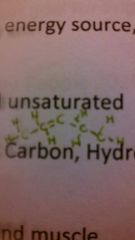![]()
![]()
![]()
Use LEFT and RIGHT arrow keys to navigate between flashcards;
Use UP and DOWN arrow keys to flip the card;
H to show hint;
A reads text to speech;
39 Cards in this Set
- Front
- Back
- 3rd side (hint)
|
Nutrition
|
The science of nutrients the food the substances therein in their action action their interaction and balance in relation to health and disease and the process by which the organism ingest absorbs transports utilizes and excretes food substances substances
|
The science of
|
|
|
Simple Carbohydrates
|
Sugars
|
|
|
|
Complex Carbohydrates
|
Starch and Fiber
|
|
|
|
Amount of Energy from 1 grm Carbs
|
4kcal
|
|
|
|
Energy from one gram of fat
|
9kcal
|
|
|
|
Lipids composed of
|
fats,oils,cholesterol
|
|
|
|
Lipids Facts
|
Are the major form of fat in food, key energy source, and fat storage in body, made from glycerol and fatty acids
|
|
|
|
Saturated Fatty Acid
|
H H H H H
H-C-C-C-C-C-H H H H H H |
|
|
|
Unsaturated Fatty Acids
|

links of Hydrogen and Carbon
|
|
|
|
Elements Protein
|
Carbon, hydrogen, oxygen, and nitrogen
|
|
|
|
Functions of Protein
|
Major part of bone and muscle, components in blood, cell membranes, enzymes, and immune factors.
|
|
|
|
Energy from protein per gram
|
4kcal
|
|
|
|
Protein formation
|
The bonding together of amino acids is called synthesis reaction
|
|
|
|
2 Vitamin Types
|
Water soluble and fat soluble.
|
|
|
|
Water Soluble
|
Has vitamin C & B, more easily excreted from the body, and low risk of toxicity.
|
|
|
|
Fat Soluble
|
Has vitamins A, D, E, & K. Is more easily stored in the body and has greater risk for toxicity.
|
|
|
|
Vitamins enable what
|
Chemical reactions - they are part of enzymes and work as co - enzymes.
|
|
|
|
Do vitamins provide usable energy?
|
No.
|
|
|
|
What are minerals?
|
They are in organic compounds required for body functions.
|
|
|
|
Major mineral
|
Is required in gram amounts.
|
|
|
|
Trace minerals
|
Is required in less than 100 milligrams daily
|
|
|
|
Water as a macro nutrient
|
It is required in the largest quantity
|
|
|
|
The functions of water
|
It is a lubricant, solvent, transportation medium, and it regulates body temperature.
|
|
|
|
Energy from alcohol
|
7kcal/gm
|
|
|
|
Overnutrition
|
Toxicities and obesity
|
|
|
|
Healthy people 2020
|
A set of health - related goals for the American public: adults exercise, adults that are obese, children/adults that are obese, vegetable consumption.
|
|
|
|
For macro nutrients
|
Carbs, proteins, lipids, water
|
|
|
|
To micro nutrients
|
Vitamins and minerals
|
|
|
|
Recommended daily allowances
|
They are for vitamins and minerals, they prevent deficiency and disease, varies by age, sex, pregnancy status.
|
|
|
|
Adequate intake needs more than
|
RDA
|
|
|
|
Daily values
|
Nutrition standards on food labels. Everyone over 4 years old except. Usually based RDA/AI group with highest need. It is based on a 2000 calorie diet
|
|
|
|
Nutrition facts panel
|
Total calories, calories from fat, total fat, saturated fat, trans fat, cholesterol, sodium, total carbohydrates, fiber, sugars, vitamin A, vitamin C, calcium, and iron.
|
|
|
|
Label Claims
|
Food label claims new chain claims: low fat, good source of vitamin c, must meet FDA standards.
Health claims: any claims that mention disease, FDA be approved, All health claims must have 'may' or 'might' in them. Structure function claims: FDA approval not required and must not name a specific disease. |
|
|
|
Nutrient claims
|
Reduced -25% less than the original
Light - 50% less than the original Low fat - <3 g/ serving Low sodium - <4 mg per serving Enriched/Fortified -10% + than normal Good source - >10% per serving Excellent/rich/hi - >20% per serving Healthy-... |
|
|
|
Milk labeling
|
Whole milk:3.5% fat
Reduced fat: 2% fat Low fat: 1% fat Fat free, skim, nonfat: 0% fat |
|
|
|
Nutritional supplements
|
Does not require FDA approval, does not need to be proven safe or effective, structure function claims OK, cannot came to cure a disease.
|
|
|
|
USDA Dietary Guidelines
|
It often addresses inadequacy is. Address adequate nutrients with in energy needs.
weight management. Food groups to encourage. Physical activity. Sodium and potassium. Alcoholic beverages. Fats. Food Safety. Carbohydrates. |
|
|
|
My plate
|
Full of half full of vegetables and fruits, paired with lean protein whole grains and low fat dairy
|
|
|
|
Food structure progression
|
The food pyramid was inadequate and it was changed due to obesity
|
|

